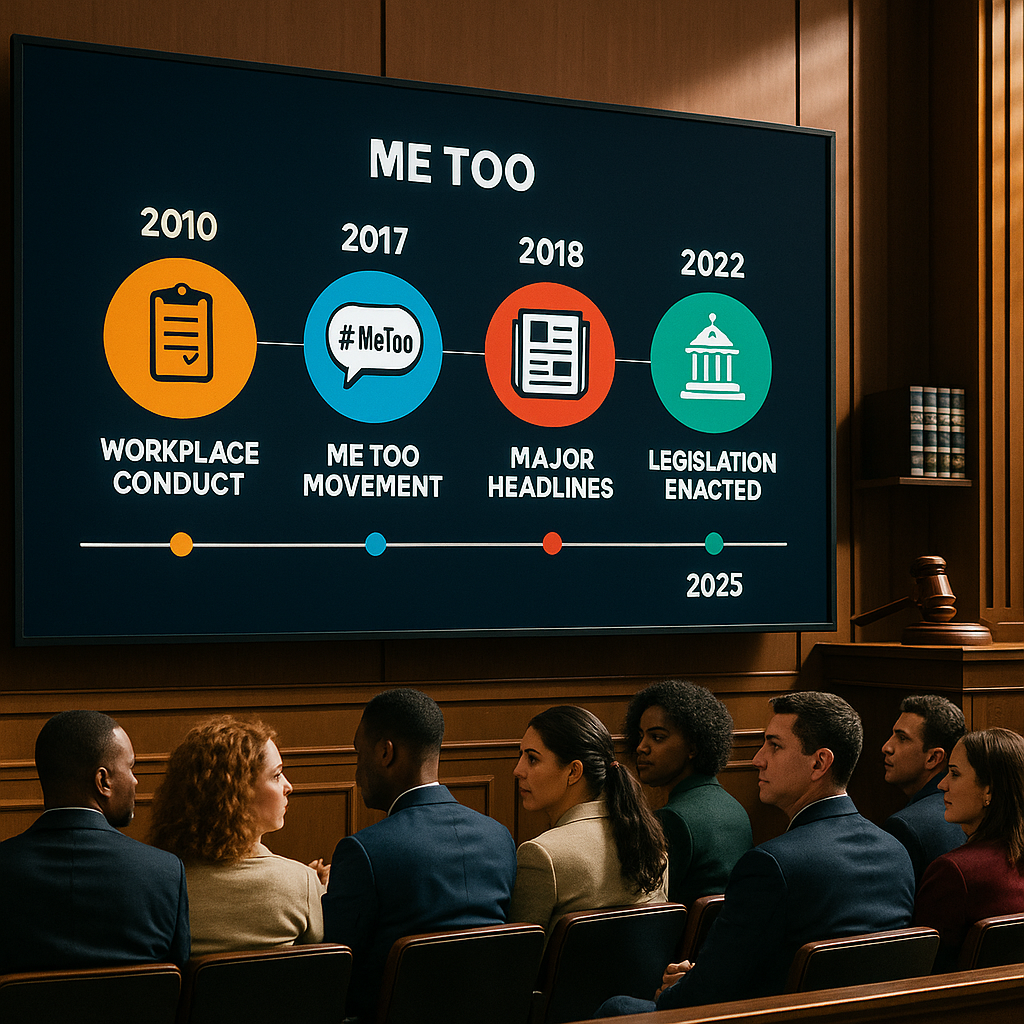One of the most fascinating challenges in trial persuasion is deciding whether to take jurors back in time. When a case involves conduct from a decade ago—or even just a few years ago—the cultural lens through which people saw the world was different. What was acceptable in 2012 might look outrageous in 2025. What seemed overlooked in the pre–Me Too era became headline-worthy by 2017. And even that lens has shifted again since.
As trial consultants, we often rely on a trial graphic to give jurors context. A good trial graphic can reset their perspective, reminding them what “normal” looked like when the conduct occurred. But like all powerful persuasion tools, this strategy has both pluses and minuses.
Why Taking Jurors Back Can Work
1. Context Creates Fairness
Jurors want to be fair. They know they’re judging past conduct, and they’re often open to guidance. A trial graphic that situates an event in its proper era can be invaluable.
Take, for example, a timeline of corporate sexual harassment policies. If the incident happened in 2013 and your graphic shows that the first serious policy overhaul didn’t occur until 2018, that image does more than words ever could. It reminds jurors that judging 2013 by 2025 standards is unfair.
2. Cooling the Heat of Outrage
Jurors sometimes respond with modern moral outrage. But outrage is a tough persuasion obstacle. You can’t out-argue it with words. You can, however, redirect it with visuals.
A trial graphic showing, for example, the lack of public conversation on harassment before Me Too, or a side-by-side of headlines from 2015 and 2018, can cool that reaction. The juror doesn’t excuse the conduct, but they begin to understand it in context.
3. Making the Distant Past Real
For younger jurors, even the mid-2000s might as well be ancient history. Trial graphics that show the absence of social media platforms, or how few companies had training programs, help make the past feel real. It’s a form of persuasion through time travel: not just telling jurors what the world looked like, but showing them.
Why It Can Backfire
1. Looking Like Excuse-Making
The danger is obvious: jurors may see your attempt as excuse-making. That’s especially risky when the behavior involves power, harassment, or discrimination.
If your trial graphic suggests, “Everyone thought this was okay back then,” jurors may recoil. Many will think, “Maybe so, but it was never really okay.” If your visuals even hint at minimizing harm, they can damage credibility fast.
2. Risk of Confusion
Jurors crave clarity. Over-engineer your time-traveling story, and they’ll get lost. A complicated trial graphic with too many data points or cultural references muddies your core message.
Instead of thinking, “That’s fair context,” they may think, “Why are we even talking about all this?” And if jurors are confused, the other side wins by default.
3. Anchoring in the Wrong Era
Even if you succeed in pulling jurors back to, say, 2012, they may still apply today’s standards. Worse, you risk anchoring them in a way that emphasizes guilt. If the jury thinks, “Even then, this was unacceptable,” you’ve just cemented the plaintiff’s theme.
Lessons from Me Too
Few cultural shifts illustrate this better than Me Too. Before 2017, workplace misconduct stories surfaced occasionally but rarely toppled careers. After Me Too, the same conduct could end a reputation overnight.
A trial graphic showing a timeline of headlines before and after 2017 makes the shift obvious. Jurors can see that tolerance for misconduct collapsed almost instantly.
But this lesson cuts both ways. If jurors think misconduct was always wrong, regardless of headlines, your “time travel” strategy fails. The gap between “not widely punished” and “socially acceptable” is narrow. And jurors may not accept it.
Practical Guidelines for Using Trial Graphics as Time Machines
-
Anchor, Don’t Excuse
Your trial graphics should anchor jurors in context, not justify behavior. A timeline showing when policies changed or when public awareness shifted should feel neutral and factual—not like spin. -
Frame as a Fairness Tool
Jurors want fairness. Position your trial graphic as giving them the tools to be fair. For example: “We want you to evaluate this conduct by what people knew at the time. Here’s what that looked like.” -
Choose One or Two Visuals
Don’t overdo it. One powerful graphic—a timeline, a snapshot of headlines, a simple comparison—is usually enough. More than that, and you’re lecturing, not persuading. -
Test Before Trial
Use a mock trial or focus group. See if jurors interpret your trial graphic as explanation or excuse. If it leans toward excuse, scale back. The last thing you want is a juror rolling their eyes at what looks like rationalization.
The Broader Lesson
The law is inherently backward-looking. Contracts, policies, and behavior all happen in the past. But jurors sit firmly in the present.
The role of the trial lawyer—and the trial consultant—is to bridge that gap. Trial graphics are uniquely suited for this. They are visual time machines, resetting jurors’ perspective so they can weigh conduct fairly. But as with any time machine, there are risks.
The art lies in subtlety. One image can do more than a thousand words. A single timeline can remind jurors of the world as it was without suggesting that world was right. That’s persuasion at its finest: combining words and pictures to take jurors on a journey they can’t forget.
Conclusion
Taking a jury back in time is sometimes essential. Other times, it distracts. The trick is knowing the difference—and knowing how to use a trial graphic to make the trip persuasive, not perilous.
At Persuadius, we’ve built our reputation on the idea that words plus pictures equal persuasion. When those pictures include trial graphics that show jurors not just what happened, but when it happened, we give them the tools they need to judge fairly.
Ready to Strengthen Your Next Case?
If your case involves conduct from another era, don’t leave the story to chance. A well-designed trial graphic can mean the difference between jurors misunderstanding and jurors truly seeing the case through the right lens. ↗️ Set-up a phone meeting or✉️ email Persuadius to learn how our team of litigation consultants, trial technicians, and graphic experts can help you build visuals that persuade.
Related articles on the Persuadius blog, The Litigation Consulting Report, that tell a story about a trial graphic, taking a jury on a journey through time, or using timelines effectively.
-
5 Ways to Make Time Comparisons Unforgettable at Trial — Tips and vivid examples for creating memorable timelines that illustrate how events relate over time.
-
Litigation Graphics: Timelines Can Persuade Judges and Juries — A classic article explaining why timelines are one of the most effective tools for conveying who did what and when.
-
Top 5 Trial Timeline Tips — Practical design advice for making timelines clear, impactful, and juror-readable.
-
The Science of Storytelling: How Trial Graphics Can Help You Tell a Compelling Narrative — A deeper dive into the neuroscience behind storytelling and how visuals reinforce narrative memory and emotion.
-
How Does Narrative Strategy Improve Trial Outcomes? — Explore how narrative framing shifts perceptions and favors persuasive outcomes in litigation.
-
Crafting Compelling Legal Arguments Using Storytelling Techniques — Paint a Picture for Your Jury — A focused guide on building emotion, structure, and imagery into trial narratives.
-
The Top 10 Tricks for Using Storytelling for Persuasion in Litigation — Tactical techniques to enhance persuasive storytelling in the courtroom.






Leave a Comment